There are two flankers in the starting fifteen players on a rugby union team. They wear the six or seven shirts and are often distinguished as the “blindside” and “openside” flanker.
This article describes the role of a flanker in rugby and the differences between the two types.
What Do Flankers Do In A Rugby Team?
Flankers are typically the fastest forwards in the team. This is due to their specialist roles in attack and defense.
They protect the ball when their teammates are tackled and ensure that the opposition doesn’t get possession.
They keep up with attacking play and provide support to receive passes or engage in rucks. (If you’re not sure about the breakdown, check out our beginner article on rucking in rugby).
The defending team’s flankers compete for the ball at opposition rucks and try to turn over possession.
Their vital defensive role results in flankers making the highest number of tackles in a match.
The rest of the article looks in more depth at the different tasks and roles for flankers. We’ll also explain the differences between the blindside and openside positions.

Flankers Attack And Protect The Breakdown
The “breakdown” is when the ball carrier is tackled to the ground. The tackled player must release the ball on the ground and the laws of rugby allow for a contest for the ball.
The flankers’ role is to follow the play and arrive fast at breakdowns.
You may not see both flankers run to a breakdown. The second flanker may anticipate that the ball will go wide again and may run to get to a wider position.
But often, the two defending flankers hunt in pairs. One will tackle the ball carrier, while the other waits for a few beats and then gets into position to compete for the ball.
This is known as jackling. We’ve marked the jackler and tackler in the picture below. The crouched player in green is also a flanker trying to protect possession.
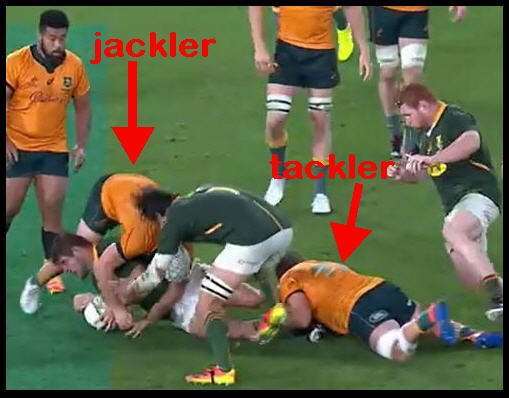
Attacking flankers protect the breakdown
The flanker on the attacking team must protect the ball when their teammate is tackled.
They will crouch over the ball to form a ruck. The opposition players will try to shift them out of the way, so the flanker must have the strength to keep their position.
Defending flankers attack the breakdown
The flanker on the defending team will “attack” the breakdown to try to disrupt the opposition play.
A good outcome is if they slow the opposition play down, forcing more attacking players to join the ruck to protect the ball.
The best outcome is when the defensive flanker can get their hands on the ball while staying on their feet.
If they can grab or “steal” the ball for their own side, this is known as jackalling.
If the ball carrier keeps holding the ball to stop the turnover, the referee will award a penalty to the defending team.
In both circumstances, the flanker has secured possession for their own team. This can be the difference between winning and losing a game.
What qualities does a flanker need for breakdown work?
Flankers need to be fast and cover the ground quickly as they follow the play. This means that they tend to be a little smaller in bulk than prop forwards and locks.
However, they need good upper body strength to compete and jackal effectively at the ruck.
Flankers also tend to be not as tall as other players in the pack. Again, this is because they need to get low to the ground when jackaling.
We’ll see later that flankers typically tackle the most in a match. Being less tall than a typical lock helps flankers tackle low and bring bigger players to the ground.
Highest Number Of Tackles In The Team
Flankers make the highest number of tackles in most matches.
As you can see in the graph below from a recent Six Nations tournament, other forwards are close. But both flankers are out in front.
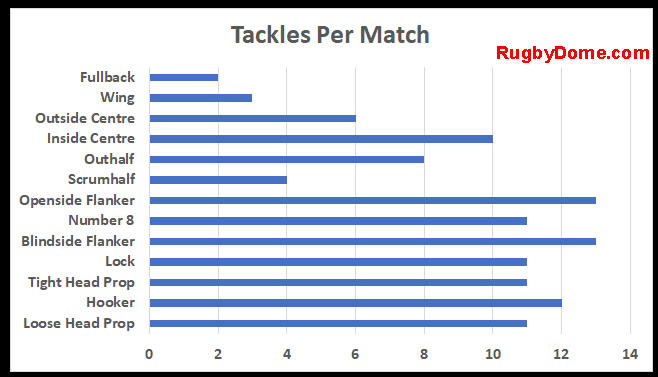
We have lots more details in our article on how many tackles that rugby players make in each position.
What Do Flankers Do In Attack?
The role of the flanker has changed greatly from the early days of Rugby Union.
The flanker’s role used to be to push in the scrum and compete at rucks. The role was greatly changed by an English player named Wavell Wakenfield.
You may never have heard of him unless you’re a Harlequins fan. But we’ve ranked him at #2 in our list of the top five English flankers of all time. He’s the reason for the modern role of flankers in attack.
You may hear commentators refer to good flankers providing “link play” or “continuity”.
This happens when the flanker is supporting the wider players in an attacking move.
Taking a pass
When their teammate is about to be tackled, often the flanker will get into position to protect the breakdown.
But they are also in position to take an inside pass or a short pop pass from the attacker.
If you want to know more about passing, check out our article on the eleven different types of passes in rugby.
Hands like dinner plates?
Receiving a hurried pass under pressure requires practice and skill. This falls under the category of “ball handling” which is a key requirement for a flanker.
However, some great flankers didn’t rank high on this attribute.
One rugby commentator referred to Scottish openside flanker Finlay Calder as having hands like dinner plates.
You can read the background to this and many more of Bill McLaren’s legendary rugby quotes.
The heart of continuity and link play
Flankers who are less confident about their own passing skills will put their heads down and charge forward towards the next defender. This can be very effective!
But the more rounded flankers can also throw an accurate pass to another teammate. This is known as link play. As it keeps the ball moving, it’s also known as continuity play.
Continuity also comes when flankers don’t wait for the scrumhalf to arrive at the back of the ruck.
If the game-plan is to keep the ball moving, the flanker may quickly pick up the ball and pass it out wide.
Of course, the opposition flankers are using all their skills to slow down this attacking play – and at best, steal the ball.
Where Are Flankers In The Scrum?
This picture highlights the six and seven jerseys in scrum formation. They form the back row i.e. the third row.
The flanker is on either side of the number eight. In other words, they form the flanks of the scrum.
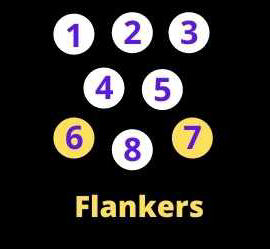
If I gave a wide view of the pitch, you’d see the larger area of open field on the right of this scrum. The touchline is closer to the left.
The openside flanker packs down on the side of the scrum that has the most open space to attack or defend.
The blindside flanker is on the narrower side.
What about the third member of the back row? We have a full article on the role of the number eight in rugby.
What Do Flankers Do In Scrums?
The props and locks may chuckle and say that flankers don’t do much in the scrum!
But don’t listen to those knuckleheads! Flankers do have an important role. However, their role becomes most important when the scrum is completed.
How do you bind as a flanker?
The laws of rugby say that every forward in the scrum must be “bound”. This means they are in contact with the other players.
The flankers crouch down on either side of the number eight. They bind with their inside arm along the back of the lock that is slightly to the front of them.
Do flankers push in the scrum?
A pack exerts the most pressure in the scrum when flankers join in pushing forward. The flankers drive the locks forward, and this force is transferred to the props.
However, you’ll often notice flankers with their heads up and very “lightly” bound. Commentators may mention that the flanker is “hanging off” the scrum.
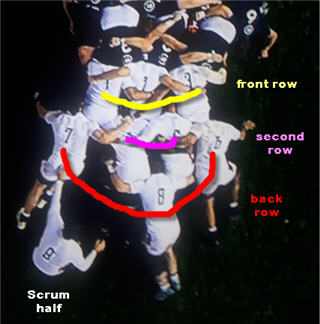
In this case, they are clearly not providing much grunt or push in the scrum. This is a tactical decision for the flanker.
It’s not because of not wanting to make an effort (although some club flankers I know like to take a little rest at the scrum!).
The reason is that flankers have other specialist roles at the scrum.
Defensive role in scrums
Many attacking plays off a scrum will move the ball out wide to the flyhalf. The openside flanker must race laterally to support the first breakdown as his backs tackle the attacking players.
Attacking number eights love to pick up the ball and charge forward toward a vulnerable flyhalf. The openside flanker should take the eight down before damage is done.
Fewer plays go up the blindside, but they can be devastating if not defended correctly. The blindside flanker protects breaks up the touchline.
Attacking role in scrums
The openside flanker on the attacking team must know the planned play off the scrum.
If the ball goes wide, the openside races to provide support play. Sometimes the means taking an inside ball from the flyhalf.
Often it means protecting the breakdown when their centres are tackled.
Flankers In The Lineout
Unlike the scrum, the lineout positions are more variable.
Catching and lifting
You’ll often see lighter flankers loitering at the back of the lineout.
Openside flankers tend to be lighter than blindsides and have extra specialist duties as jumpers in the lineout.
A lighter player can be flung up high by the lifters to take a long throw. Here is an openside lifted high to take the catch.
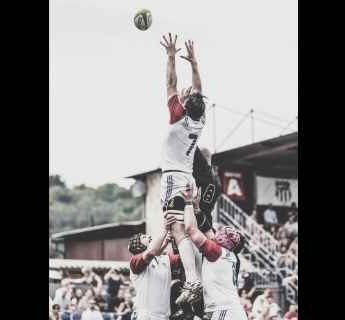
This is one of the best attacking plays when it works. The rest of the opposition forwards are tied into one area of the pitch while the attacking team quickly gets the ball out wide.
Flankers also have to be skilled at lifting locks.
Away from the lineout
Sometimes you’ll hear a referee ask a forward if they are part of the lineout.
This is because they’re loitering a little too close to be legal. Players who aren’t part of the lineout must be a certain distance away.
Lineout plays sometimes put a flanker into the traditional scrumhalf role. The good ball-handling flankers can receive the ball. They will charge forward to initiate the attack or act as a link by passing the ball out wide.
The flanker may also hang out in the middle of the backline with the centres. This adds a bit of bulk to the attack.
Defending the lineout
The defending team also tends to position a flanker at the back of the lineout. This player must be ready to tackle attacking forwards running around the back of the lineout.
They must also be ready to race across the pitch to defend against wider plays.
What Is The Difference Between Blindside And Openside Flankers?
Most players in the back row can put in a shift at six, seven, or eight.
Having specialist blindsides and opensides is a fairly recent phenomenon in the sport.
Before this came about, flankers tended to pack down on the left or right of the scrum – regardless of where the scrum was on the pitch. In other words.
However, the roles have become more differentiated. This is mostly due to the openside flanker having to cover more ground faster to keep up with the modern fast-moving game.
How the openside flanker is different
The openside tends to be faster than the blindside. They must spring up from tackles and move fast to get into a new defensive position. This means they also tend to be more agile.
This combination of speed and agility means that they typically carry less bulk than the blindside. In other words, they are lighter and faster.
How the blindside flanker is different
A forward pack must provide grunt and ballast. If the pack has a lighter flanker, then the blindside must make up for it.
Blindsides are typically bigger and heavier than the loosies. This also means that they are expected to put their bulk to good use.
Blindsides like put in the big hits and dominant tackles.
They are also used as battering rams in attack. Even if they don’t break through, the goal is that it takes two or more defenders to take them down. This gives the attacking team extra players on their feet.
Great Flankers Through History
We’ve put together some background and descriptions of the greatest flankers the sport has seen. Check out these articles:
- Top Ten World’s Best Flankers In Modern Rugby
- Five Best English Flankers Of Time
- Five Best Irish Flankers Of Time
Rugby Quiz!
Think you know your rugby?
Let's see if you can match the quote to the player or coach!
Here are seven quotes. How well will you do?
